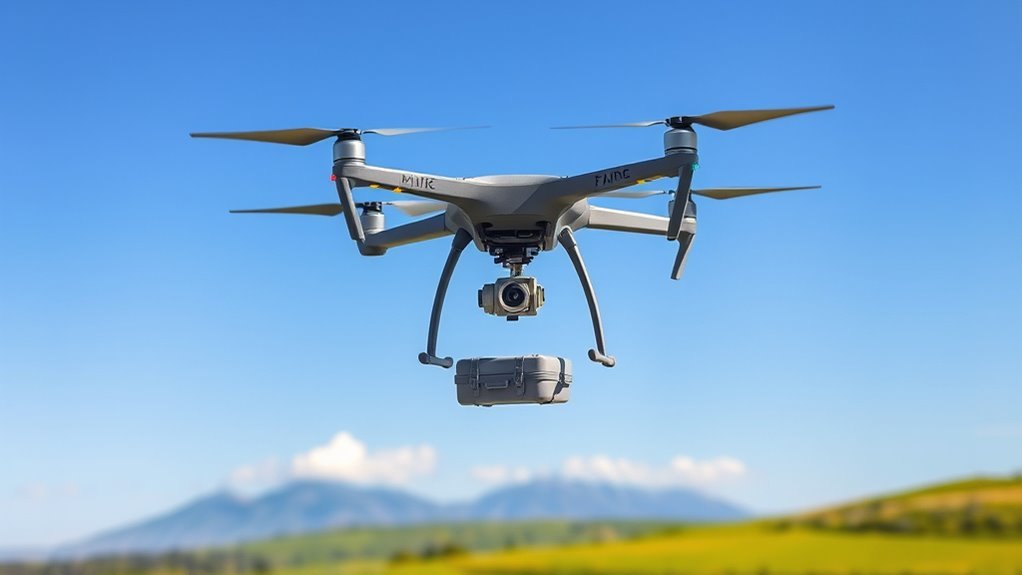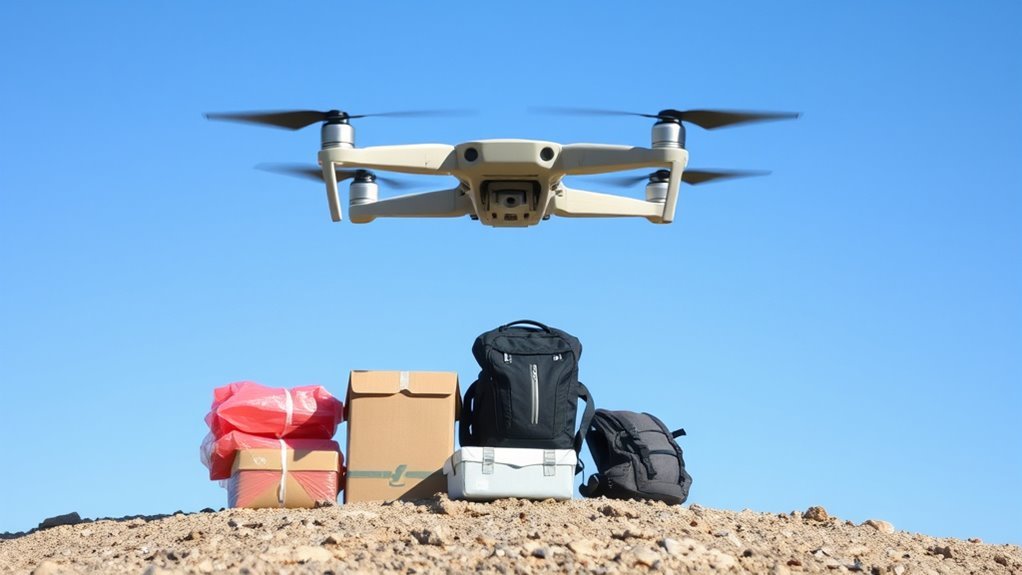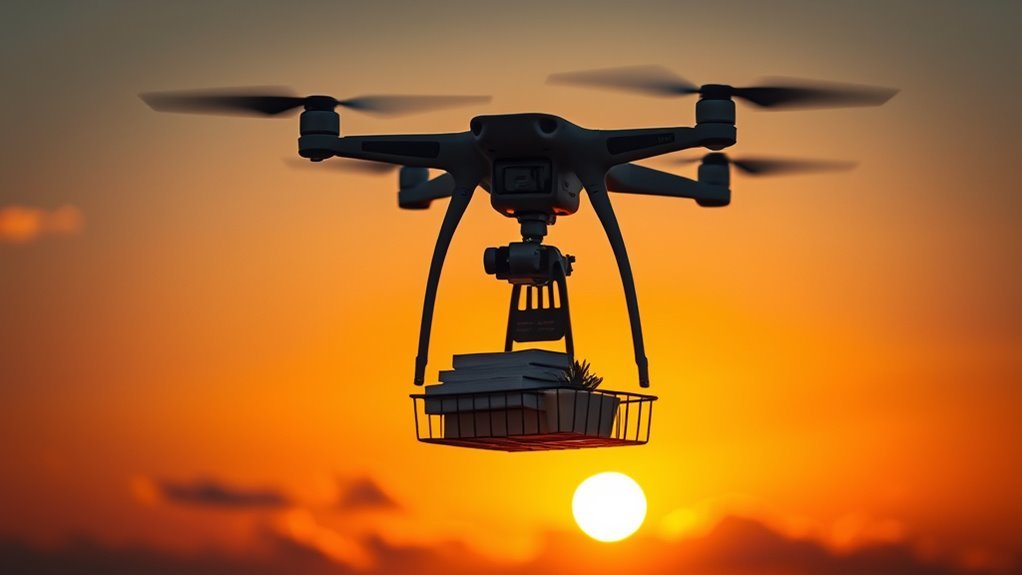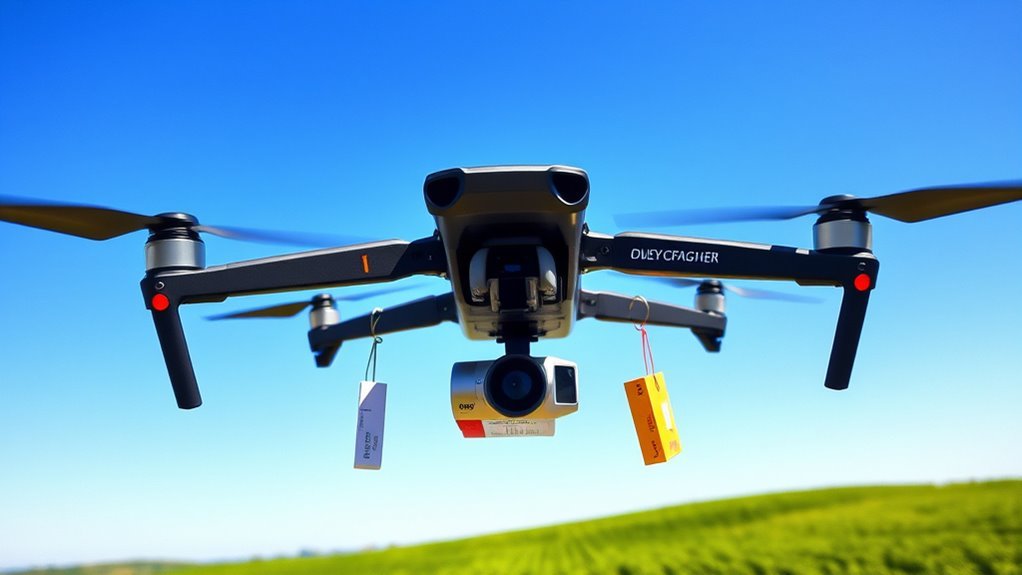Drones can carry weights ranging from a few hundred grams to over 30 kilograms, depending on their type and design. Multirotor drones typically support up to 10 kg, while fixed-wing drones can handle up to 20 kg. Hybrid models offer even greater capacity, up to 25 kg, and agricultural drones can transport 30 kg. Understanding these limits is essential for ideal performance and compliance with regulations, so you can effectively plan your drone operations.
Understanding Drone Payload Capacity

When exploring drone payload capacity, it’s crucial to understand that this metric directly influences a drone’s operational effectiveness. You need to evaluate how payload affects drone efficiency; heavier loads can strain motors and reduce flight time. The Amazon MK30 can transport up to 5 pounds with minimal range reduction, showcasing the importance of balancing payload with overall design to enhance performance while guaranteeing stability. Each drone model has a specific payload limit, which dictates the types of tasks it can perform. Whether you’re delivering packages or conducting aerial surveys, understanding these limits allows you to make informed decisions. Ultimately, achieving ideal payload capacity guarantees you maintain the freedom to execute diverse missions without compromising drone capabilities or safety. Moreover, knowing the maximum payload capacity of the drone you’re using is essential to optimizing its performance for specific tasks.
Factors Affecting Weight Limitations

When evaluating a drone’s weight limitations, you need to take into account several critical factors. Drone design specifications play a significant role, as they dictate the structural integrity and load-bearing capabilities. Additionally, battery capacity and payload distribution techniques can substantially influence how much weight a drone can effectively carry. Furthermore, the impact of weight distribution on flight stability is crucial for maintaining control and efficiency during operation. For instance, the payload capacity of drones like the Wasp and Commander demonstrates how design choices can optimize performance based on mission needs.
Drone Design Specifications
Although various factors influence a drone’s weight limitations, design specifications play a significant role in determining its payload capacity. Key design elements directly impact both aerodynamic efficiency and structural integrity, ensuring drones can safely carry heavier loads without compromising performance.
Consider these three essential specifications:
- Frame Material: Lightweight composites enhance strength while reducing overall weight.
- Propulsion System: High-thrust motors improve lift capability, allowing for greater payloads.
- Wing Design: Optimized shapes reduce drag, boosting aerodynamic efficiency for better flight performance.
Together, these specifications dictate how much weight your drone can handle, balancing the need for freedom in flight with the mechanical limits of its design.
Battery Capacity Impact
Battery capacity considerably influences a drone’s weight limitations, as insufficient energy reserves can restrict both flight time and payload capability. When you consider battery efficiency, it is crucial to recognize that higher capacity batteries can support heavier loads for longer durations. However, this often comes at the cost of increased weight, leading to a fine balance between battery weight and payload capacity. To maximize performance, you’ll want to focus on weight optimization strategies, ensuring that the drone’s design accommodates the most efficient battery type while minimizing unnecessary heft. Ultimately, selecting the right battery not only enhances your drone’s operational efficiency but also expands its potential applications, giving you greater freedom in utilizing the drone’s capabilities for various tasks.
Payload Distribution Techniques
Optimizing payload distribution is essential for maximizing a drone’s performance and ensuring it operates within its weight limitations. Effective payload optimization strategies can greatly enhance flight stability and efficiency. Here are three key techniques you should consider:
- Center of Gravity: Position your payload near the drone’s center of gravity to maintain balance.
- Symmetrical Load Distribution: Distribute weight evenly across all arms to prevent tilt and enhance control.
- Dynamic Load Adjustment: Use load balancing techniques to modify payload distribution in real-time during flight, adapting to changing conditions.
Types of Drones and Their Carrying Abilities

When considering the carrying abilities of drones, it is essential to understand the various types available and their specific payload capacities. Different drone types cater to varying payload types, which directly impacts their utility for specific applications. Here’s a concise overview:
| Drone Type | Payload Capacity |
|---|---|
| Multirotor | Up to 10 kg |
| Fixed-Wing | Up to 20 kg |
| Hybrid | Up to 25 kg |
| Single-Rotor | Up to 15 kg |
| Agricultural | Up to 30 kg |
Understanding these capacities helps you choose the right drone for your needs, ensuring effective operation and satisfaction. Additionally, higher payload limits in advanced drones like the Freefly Alta X significantly broaden their application scope, whether you’re delivering supplies or conducting surveys. Knowing these specifications reveals your potential in the drone space. Moreover, advancements in heavy-lift drones have significantly improved payload capabilities, opening new possibilities for various applications.
Commercial Drones for Package Delivery
When considering commercial drones for package delivery, it’s essential to evaluate their payload capacities alongside regulatory weight limits. These factors directly impact the efficiency and feasibility of drone delivery systems. Understanding the interplay between what drones can carry and what regulations permit will inform your operational strategies. The payload capacity of drones like the Amazon MK30, which can handle up to 5 pounds, significantly influences delivery options and service efficiency. Additionally, the MK30’s design prioritizes reliable, autonomous operations for package delivery, ensuring safety while optimizing delivery efficiency.
Payload Capacity Considerations
Although payload capacity is a vital factor in the efficiency of commercial drones for package delivery, it’s essential to contemplate various elements that influence this capability. Effective payload management and weight optimization are important for maximizing delivery efficiency. Here are three considerations:
- Drone Design: The physical structure impacts how much weight can be safely carried.
- Battery Life: Heavier payloads may reduce flight duration, affecting delivery range.
- Environmental Factors: Wind and weather conditions can alter lifting efficiency and stability.
Regulatory Weight Limits
As regulations shape the landscape of commercial drone operations, understanding weight limits becomes essential for effective package delivery. Regulatory frameworks, such as those established by the FAA, impose specific weight restrictions that can dictate your operational capabilities. Typically, these limits vary based on factors like drone class and intended use. Maneuvering these compliance challenges is critical to guarantee your drone operations remain lawful and efficient. Exceeding weight limits can lead to penalties and operational disruptions, ultimately affecting your service reliability. To maximize your delivery potential, staying informed about evolving regulations and weight thresholds is significant. This knowledge empowers you to strategically plan your payloads while maintaining adherence to the necessary legal standards.
Drones in Medical Supply Transport
Drones are increasingly playing an essential role in medical supply transport, with their ability to deliver necessary supplies quickly and efficiently. Utilizing drones for medical deliveries offers several advantages:
- Speed: Drones can cover vast distances in minutes, guaranteeing critical supplies reach their destinations without delay.
- Accessibility: They can reach remote, hard-to-access areas, providing crucial medical support where traditional transport methods may fail.
- Cost-effectiveness: Drones reduce transportation costs by minimizing the need for extensive ground infrastructure.
These drone advantages not only enhance the efficiency of medical deliveries but also improve healthcare outcomes in underserved regions. By leveraging these innovative technologies, you can assure that life-saving supplies are available when and where they’re needed most.
Agricultural Drones and Payload Management
When considering agricultural drones, understanding payload capacity is essential for optimizing their effectiveness. Each application has specific weight limits that can impact performance and efficiency. Evaluating these factors will help you maximize the benefits of drone technology in farming. For instance, the payload capacities of drones like the Delair UX11 AG and Guardian Evtol can significantly influence how often operations need to be conducted. Additionally, the flight stability of drones, such as the Guardian Agriculture Drone, ensures reliable performance even in challenging conditions.
Payload Capacity Considerations
Understanding payload capacity is essential for enhancing agricultural drone performance, especially since the amount of weight a drone can carry directly influences its efficiency and operational effectiveness. To maximize your drone’s capabilities, consider these payload enhancement strategies and weight distribution methods:
- Balanced Load: Guarantee even weight distribution across the drone to maintain stability during flight.
- Lightweight Materials: Use lightweight containers or attachments for chemicals and seeds to minimize total weight.
- Incremental Testing: Gradually increase payload weight during trials to identify the best limit without compromising flight safety.
Application-Specific Weight Limits
While agricultural drones offer significant advantages in efficiency, their payload limits must be tailored to specific applications for ideal performance. In drone engineering, understanding the relationship between weight and functionality is essential. For tasks like crop spraying or seed dispersal, payload refinement guarantees you maximize effectiveness without compromising flight stability or battery life. Each application has unique demands; for instance, heavier payloads can reduce maneuverability, affecting precision in variable terrain. By strategically managing payload based on the task, you can enhance operational efficiency and reduce costs. Ultimately, knowing the specific weight limits for your agricultural drone helps you leverage its capabilities, allowing you to operate with greater freedom while achieving optimal outcomes in your agricultural endeavors.
Innovations in Drone Design for Increased Capacity
As advancements in materials science and aerodynamics continue to evolve, drone manufacturers are increasingly focused on enhancing payload capacity without sacrificing performance. Innovations like lightweight materials and modular designs enable you to optimize payload capabilities. Here are three key developments:
- Advanced Aerodynamics: Streamlined shapes reduce drag, allowing for greater lift and efficiency. Drones like the Freefly Alta demonstrate how aerodynamic designs can maximize payload capacity while maintaining stability in flight.
- Multi-Rotor Configurations: These designs distribute weight effectively, improving stability and increasing capacity.
- Reinforced Structures: Enhanced durability means drones can carry heavier loads while minimizing risk. Additionally, the modular design found in systems like the AeroVironment Puma allows for payload swapping, further enhancing mission adaptability.
Legal Regulations Surrounding Drone Weight Limits
Given the rapid growth of drone technology, legal regulations surrounding weight limits have become increasingly critical. These drone regulations are designed to guarantee safety and reliability in airspace management. Generally, weight restrictions vary by country, with many jurisdictions imposing limits around 250 grams to 25 kilograms for commercial use. Exceeding these limits can lead to severe penalties, including fines or confiscation of the drone. It’s essential for operators like you to stay informed about local laws, as compliance not only enhances safety but also preserves the freedom to operate drones effectively. Understanding these weight restrictions allows you to maximize your drone’s capabilities while maneuvering the legal landscape with confidence. Additionally, strategic partnerships with local authorities can assist in navigating these regulations. Always prioritize safety and legality in your aerial endeavors. Additionally, adherence to NDAA compliance can further ensure that drone operations align with national security standards.
Real-World Applications of High-Payload Drones
High-payload drones are revolutionizing various industries by enabling efficient transport of heavy materials and equipment. These heavy lift drones are transforming drone logistics, providing unprecedented capabilities. Here are three key applications:
- Construction Sites: They can deliver heavy tools and materials directly to remote locations, speeding up projects and reducing labor costs.
- Medical Supply Transport: In emergencies, these drones can quickly transport medical supplies, vaccines, or organs, saving lives by bypassing traditional transport delays.
- Agricultural Support: Heavy lift drones can carry fertilizers and pesticides across vast fields, optimizing agricultural efficiency and minimizing manual labor. Furthermore, the advanced motor and propulsion systems enhance stability and allow for reliable operation even under significant loads.
Future Trends in Drone Payload Capabilities
The advancements in heavy lift capabilities are just the beginning of what drones can achieve. Future technologies promise significant enhancements in payload capacities, driven by the integration of advanced materials like carbon fiber and lightweight composites. These materials not only reduce the overall weight of drones but also improve structural integrity, enabling higher payloads without sacrificing performance. As battery technology evolves, you’ll witness longer flight times and increased lifting power, allowing drones to transport heavier loads over greater distances. Additionally, innovations in AI and automation will optimize load management, ensuring efficient delivery and safety. Embracing these trends will empower you to explore new applications, enhancing logistical freedom and redefining the potential of aerial transport. Moreover, advancements in drone stability will also contribute to the safe transport of heavier payloads, allowing for more complex delivery scenarios.
Frequently Asked Questions
What Are the Best Drones for Carrying Heavy Loads?
Considering your needs, aren’t heavy lift drones essential for efficient commercial applications? Look into models like the DJI Matrice 600 or Freefly Alta 8, designed for robust load capacity and reliability in demanding environments.
Can Drones Carry People or Only Cargo?
Drones can potentially carry people, but strict drone regulations currently limit human transport. While advancements are being made, safety and regulatory concerns must be addressed before widespread acceptance and use of passenger-carrying drones can occur.
How Do Weather Conditions Affect Drone Payload Capacity?
Oh sure, let’s let your drone fly in a hurricane! Wind resistance can drastically reduce payload capacity, while temperature effects might further hinder performance. So, be mindful of Mother Nature when planning your drone’s weight limits.
Are There Safety Concerns With Heavy Payloads on Drones?
Yes, there’re safety concerns with heavy payloads on drones. Exceeding payload regulations can compromise drone stability, leading to potential crashes or loss of control, which could endanger both the operator and the public. Stay informed and cautious.
How Can I Calculate My Drone’s Payload Capacity Accurately?
To calculate your drone’s payload capacity accurately, check its payload specifications, ensuring you account for weight distribution. Notably, many drones can carry up to 25% of their total weight, offering you impressive freedom for various applications.

